In late March we simply had a heap of peeping fluffy chicks…
…but now it’s August, and our pullets have started laying their first eggs!
Our girls are coming online right on schedule. On average, pullets come into lay somewhere between 18-22 weeks. Ours have started laying at just over 20 weeks of age.
Beginning at 18 weeks we transitioned the pullets to an organic layer-diet that is lower in protein, and higher in calcium compared to their grower-diet, in preparation for egg-laying. We also began to leave the nest box shutters open during the day.
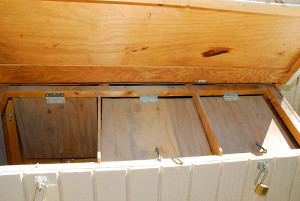
Small shutter doors between the nest boxes and the main coop allow us to control access to the nests
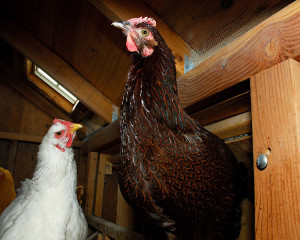
The pullets, like this Partridge Plymouth Rock, access the nest boxes from inside the coop when the shutters are open
Chickens defecate where they sleep at night, so we close the shutters at dusk to prevent the chickens from roosting in, and soiling the boxes. This keeps both the boxes, and the next morning’s eggs, clean.
With our previous hens, if we accidentally left the boxes open after dusk, one box would quickly turn into the chicken equivalent of a clown car, and five or six hens would try to squash themselves into one box for the night!
In addition to leaving the nest boxes open during the day, we also placed artificial eggs in each box.
This wasn’t to ‘teach’ the pullets where to lay eggs. Providing there are designated nest box areas, pullets are actually quite savvy, and will naturally seek out such an enclosed area to lay their eggs away from the rest of the flock. However, this time we have a large rooster in the mix. Siegfried is housed with the ladies full time. Part of our concern was that he could easily break an egg, even if it’s just out of curiosity. The artificial eggs gave Siegfried and his flock an opportunity to be inquisitive about these new objects in the coop, but these eggs can’t be broken. This desensitizes them to the sight of eggs in the nests before the real, more fragile eggs are laid.
We’re not specifically concerned with the physical loss of a broken egg per se, but broken eggs in the coop can lead to a very nasty habit in chickens. Egg eating. Once started, even if only one or two pullets engages in egg breaking/eating behavior, it is nearly impossible to extinguish this behavior once it starts. Oddly enough, chickens love the taste of their own eggs. Not particularly advantageous from an evolutionary perspective, but important to know that it can and does occur, and often starts when they first begin laying eggs due to accidental egg breakage. Desensitizing the flock to the presence of eggs, and quick retrieval of eggs once they are laid both help to prevent egg-eating behavior from starting.
So, back to our pullet eggs. Thus far it looks like just one or two of the Delaware’s have started to lay. On Tuesday, after hearing a round of rather loud clucking from one of the Delawares, I went up and peeked into the nest boxes. Nest box one…fake resin egg. Nest box two…fake resin egg. Nest box three…Oh! A PAIR of eggs!
Since Tuesday, we’ve had one additional egg each morning so far, including this morning, although not necessarily all from the same pullet.
The classic clue that a pullet is becoming sexually mature, and will soon be coming into lay, is the ‘egg squat’, where the pullet will quickly crouch low to the ground when approached by a handler (or a rooster). Additional clues are a significant reddening of both the comb and wattles, and noting an increase in the time a pullet spends investigating the nest box. Here you can see that a young Buff Orpington, accompanied by one of our Delawares, is checking out the Curbstone Valley egg-laying accommodations.
Our first little ‘pullet egg’, was just a mere 40 grams in weight, compared to the 55-70 gram eggs laid by our mature hens.
Pullet eggs, or practice eggs as they are sometimes called, are usually quite small compared to the eggs of a regularly laying hen.
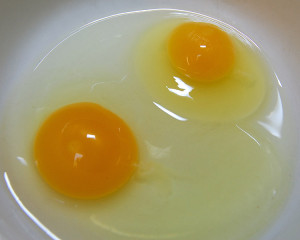
A peek inside shows that the hen egg on the left, compared to the pullet egg, is really only different in size
The pullets are just laying eggs for the first time, and as such undersized eggs are normal when they first start to lay, as the pullets themselves aren’t quite yet full grown. It’s also not unusual to occasionally find a pullet egg without a yolk, or sometimes an egg may be laid without a shell at all, or with a very thin, soft, or friable shell. This is completely normal in newly laying pullets, providing after a few false starts, their egg production normalizes. We’ll get into the complexities of egg-formation in a future post. However, as mentioned before in regards to egg eating, it’s important to keep a close eye on the pullets at this stage so any shell-less mishaps are cleaned up quickly.
So now that our girls are coming online we expect that they’ll soon be producing lots of beautiful brown eggs, like these ones from our orchard hens.
Omelette anyone?

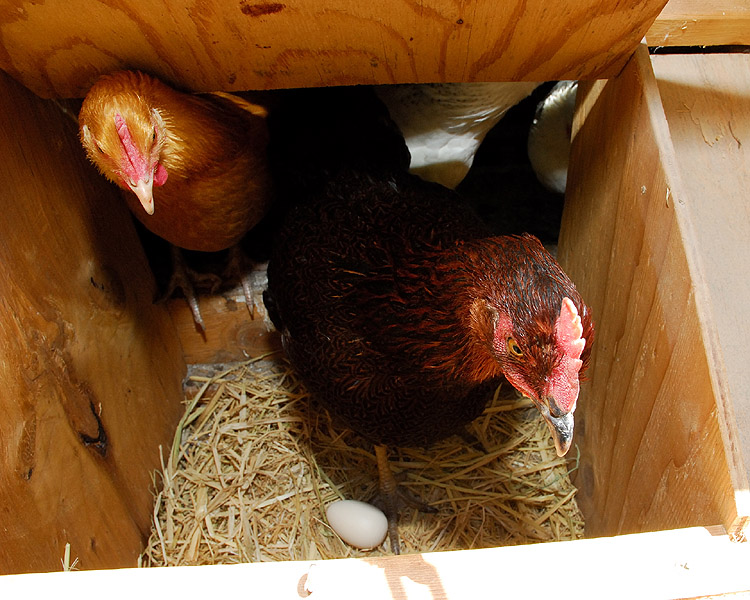
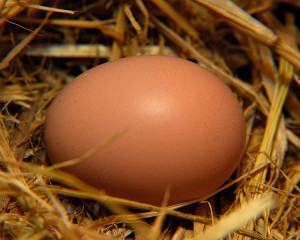
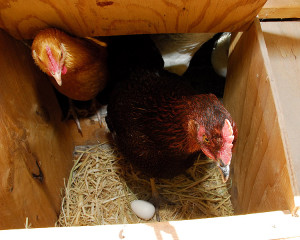
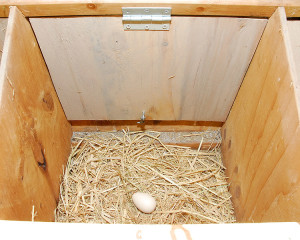
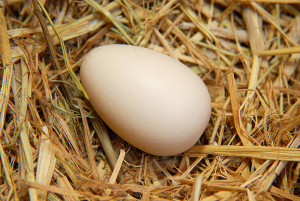
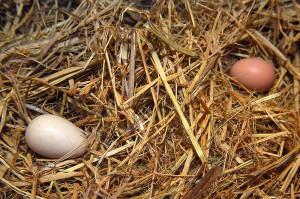

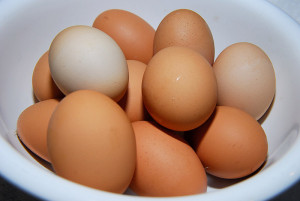
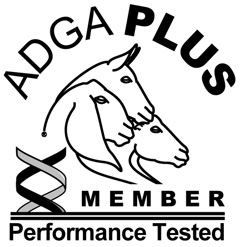






Thank you for sharing your wealth of knowledge. So enlightening. I never knew why an artificial egg was used. Our ladies occasionally feel the need to sleep in a nesting box and at one stage all four tried to cram into one. I didn’t think of shutters.
They are funny when they all try to squish into one box. Seeing the mess that has occasionally been made in a nest box that’s been left open, I’m very glad we built shutters when we constructed this coop! 🙂
Congratulations on the new generation of egg layers!
Do you think that egg eating is common if they don’t get used to a resin egg? I don’t have a resin egg, but I was thinking about using a golf ball for the same purpose. Would that work?
My girls are at least a month behind yours, so I’ve got a little bit of time to figure this out.
I don’t think egg eating is very common Jackie. When we only had a half dozen hens, we didn’t bother with the fake eggs, and they were fine. As we have so many more pullets this time, and the rooster, for the sake of a few dollars worth of fake eggs we figured it can’t hurt.
I think a golf ball would probably work just fine. We used to have a hen that laid practically round eggs anyway, so I don’t think they’d really notice the difference 😛 The fake eggs though are very cheap, and your local feed store where you purchased your chicks probably keeps them in stock. They’re usually under $1 a piece.
Clare, this is such an interesting and informative post! I neve knew young hens were called pullets and I certainly never knew they could lay eggs without yolks or shells. The size difference doesn’t surprise me, though. AWESOME information!!!
I live in a cookie cutter subdivision and as much as I would LOVE to raise chickens, I can’t, so I’m living out my chicken dreams through your blog!! Your post was amazing because it was so informative! Why do the chickens all cram into the same nest? It sounds funny to see!
I don’t know why they all feel the need to be in one nest. Safety in numbers perhaps? They actually are quite gregarious creatures, and really don’t like to be alone, but they do look ridiculous squished like sardines in a box when they crowd together at night. 😛
And now I know! Fascinating. I love your tour, I wanty to direct my grandchildren to your post. I often wonder if they think egs come form the grocery store. Very well done. I look forward to the next chapter.
oh my, can you tell my keyboard has a mind of its own? ilkdt? 🙂
How exciting! We were visiting some friends the other day and they told us their chickens just started laying too. They let my little one get the egg out of the box while we were there. One day I’d love to have chickens and fresh eggs of our own.
Will you be able to eat all of the eggs that your chickens lay?
We won’t be able to eat all of the eggs, especially the first year as their egg production is quite high until their first molt. We’re not worried though, there’s quite a demand for organic eggs from happy hens 🙂
Dear Clare, Fresh eggs. How simply delicious.Eggs Benedict, quiches, meringues, custards,scrambled and poached……so very versatile and all the more appetising knowing the provenance.
And, what provenance. The CV Chicken Hotel would be filled to overflowing with every chicken in the neighbourhood if they knew what luxury was in store for them there. Better keep it secret.
Of course, the only thing missing for me in this incredibly informative posting is news of Frodo. First is he still alive? Second, has he yet found his ‘inner rooster’?
Ah yes, Frodo. No worries, he’s still with us, and impatiently waiting for us to finish his new house! We’ll have an update on Frodo this Friday, I promise 🙂
Oh Clare – Cute reminder of how they all started out but why do chicks have to grow up? Answer: in order that they become ‘girls’ who provide uber fresh eggs – and for us to hear all about it from the CV experts. If I was keeping chickens, you would be my first reference point.
Laura –
I never knew about the benefits of “false eggs” in the nesting boxes before Clare nor about eggs without shells from the pullets. Loved reading every morsel of info this week.
Good to see your pullets are performing right on cue. How exciting to find that first egg! If I ever get chickens myself, or more likely, when Son #1 and DIL add chickens on their property, I will feel like an expert after reading your blogs. I’d love to get it going right now, but I’m famous for biting off more than I can chew, so I’m learning to be more patient as I get older.
Wow, now this is chicken raising 101, I only wish I had some chickens to raise. You make it sound so easy and fun.
Hehe…chicken clown car. What a funny visual that was 😀
Funny, I now have this image of a little clown car with a bunch of chickens jammed in it! Thank you for another informative and educational post. I appreciate the time and effort you put into it. And I’m also interested in hearing about young Frodo.
Clare – Your blog is so much fun (and informational of course) to visit. Between photos, videos and well written posts… I could get lost here! Thanks for your contribution to the garden community!
-Shyrlene
(Cool link to our blog posts too!)
fascinating…and yes, how is young frodo doing?…
At the moment Frodo looks like he’s melting in 104F heat, but tune in this next Fowl Friday for a full Frodo update 😛
Hooray! It must be exciting to find those first eggs. An omelette from freshly laid eggs sounds delicious. Your posts are always interesting and informative. Thanks!
Congrats! I love now small the first eggs always are. Very cool.
What time are you serving those omelets! I love learning about chickens, egg laying and all your adventures. With the egg industry in shambles have folks started begging eggs from you? gail
Clare, you should win the Pullet Surprise for this informative post. Aren’t you glad you have your own hens what with the half billion egg recall? I’m happy that our three girls have provided us with all of our egg needs since we got them in February.
What a great lesson in pullet eggs Clare! Congratulations on your first pullet eggs and I wish we lived close to one another… I would take you up on the omelet offer. Love you videos as always… especially the little peepers. You are so clever in how you keep the eggs clean! If only chickens could learn to walk away and poop outdoors… or at least away from their eggs. ;>))
Totally fascinating, Clare. I remember when they were baby chicks! I had no idea there was so much involved … Question … I prefer brown eggs … is there really a difference?
There really isn’t a substantive difference in egg quality based on shell color. I prefer brown eggs too, but my bias is based more on aesthetic quality than any real science. There is some evidence to show that the diet fed to the chicken (corn fed vs. allowed to forage for greens and bugs) does affect nutritional content though.
Cute little eggs! You could make mini-quiches now! (Giggle)
Love it! It was so exciting the day we got our first egg. With just two laying right now we are overwhelmed with eggs already! (they are laying two a day sometimes.. each!) I am glad you spoke of the squatting thing I have noticed this with our birds.. I just thought they didn’t like to get pet anymore but the egg thing makes way more sense.
Hello Clare, that was a truly great informative post with lots to file away for our yet to be ‘chooks of the future’!
BTW – I did enjoy the image of a ‘chicken clown car’ 😀
I agree, egg-eating is an odious thing in hens. When I was in 4H a pal had her hens start eating eggs and she had to get special battery-style laying boxes with a ramp that would trap the eggs after they rolled a bit. Expensive! But once they started, no stopping them. Another great post!! I love the wee “training eggs”!!!